|
EARLY ENGLISH WINE TASTERS :
Their Lore, Influences ...
& The 'Disputes' of Name & Purpose
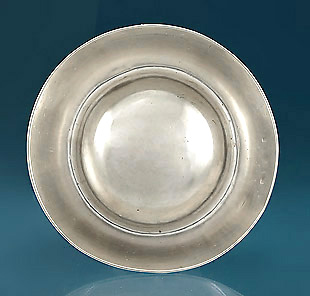
"Wine tasters" are small objects, usually of silver, used to assess the clarity and color of wine.
They generally have a lobed and/or faceted surface, and sometimes a convex base to catch as
much light as possible, reflecting it throughout the wine. These go by various names :
tastevins
taste du vins
tasting cups
wine dishes
sommelier's cups
dram cups
simply 'wine tasters'
... and suggested
alternates : 'wine cups, dipping cups, even mustard dishes'...
"THE LORE" :
Stories from the 3rd millennium BC mention wines from Zagros Mountains or Lebanon.
In the fourth century BC, Plato listed the main flavors of wine, and classified the aromas.
Aristotle proposed a sensory
'tasting', defined by the four elements (air, water, fire, and earth).
And
apparently the saucer shaped shiny
'taster'
was already in use during the Minoan*
culture.
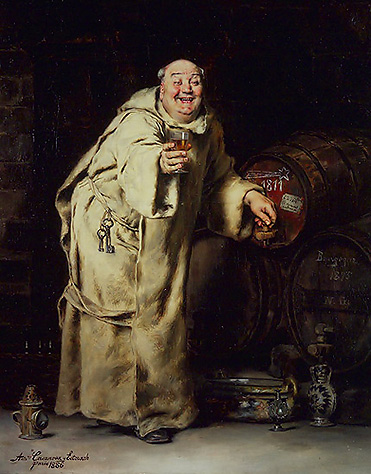
The
wine-producing region of Burgundy (east central France)
is credited with introducing
this
shallow silver cup - now recognized as the 'wine taster'
(or 'tastevin').
Wines were
matured in barrels stored in dark candle-lit cellars.
Winemakers
needed a
small
shallow shiny cup
to
allow the soft candlelight to
determine a
wine's quality, assessing its color, clarity, bouquet
... and taste.
Although the
term
'tasting'
is said not
appear until 1519,
'wine cups'
or 'tastevins' are mentioned occasionally in European
inventories from 1200 forward.
A marked silver wine
taster ("tastour of selver") is documented in a
will dated 1426.
"THE 'TRADE' & 'INFLUENCES' : FRANCE & THE IBERIAN PENINSULA"
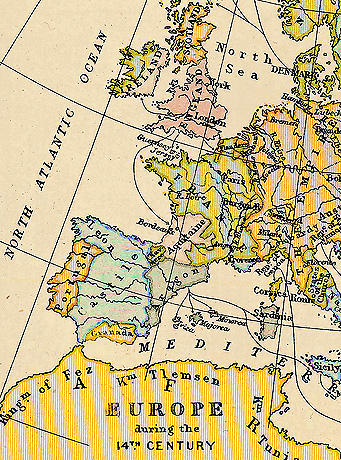
During the 12th century, alliances between and between England and
Portugal, and
England and France - particularly Bordeaux - opened the door for extensive trade in wine.
In both France and Portugal, vineyards and wine-making had long been maintained by monasteries.
Portuguese vineyards gained the Royal support of Dom Afonso Henriques,
beginning c1150.
The 1152 marriage between Eleanor of Aquitaine and England's future King Henry II
brought a large part of
southwest France under English rule, increasing the wine
trade with France**.
While English-Portuguese trade
remained strong, the English-French wine trade
began to decline in 1453 when Gascony returned to French rule.
During the 16th and 17th centuries, the Dutch dominated the French wine trade, including Bordeaux
During the reign of Charles II, several French wines returned to English fashion, including champagne.
"... EARLY 'WINE TASTERS' in FRANCE"
The
great majority of wine tasters are French, the French
name being 'tastevin',
the
moulded shape originating in Burgundy
at an apparently unrecorded date.
Each
wine growing region has its own characteristic style,
based
in part on the needs of the regional wine.
Surprisingly, French silver wine tasters were somewhat rare
until late in Louis XIV's reign.
However, about 1680, these small shallow silver tasters,
(3-3/4" wide, with no handle, or with one handle)
had become, among French affluent,
a very fashionable accessory,
even
known as the "Personal and Popular Wine Cup".
The tasters were made by master silversmiths, small enough to carry in the pocket,
as prized as the best jewelry or watches.
The personal carrying and use of wine tasters in France continued until the French Revolution.
Often, on the French taster (or tastevin) the moulding would be as
rays (raised flutes) for light to reflect through white wine,
and small wells to deepen red hues.
Sometimes the tastevin base would center a light-reflecting coin.
The single handle also might be a coiled serpent - a nod to the god of wine, 'Dionysus'.
The name of the owner or vintner might also be inscribed on the rim :
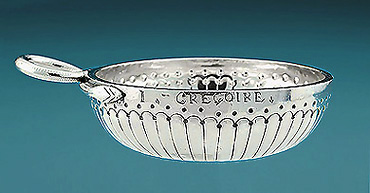
A LOUIS XV / XVI PROVINCIAL SILVER TASTEVIN
Third Quarter 18th Century, Crowned A.P Thrice (Antoine II Parrel)
with rays and wells, and a coiled snake handle,
the owner's name GREGOIRE (Gregory) engraved to the side
4.75" Over Handle / 4.5 oz. (current stock)
The southern French province of 'Bordeaux' had a slightly different version,
with wide flaring sides, domed center and no handle.
This 'DOMED FORM ' is sometimes cited as the 'ONLY TRUE ENGLISH TASTER'
:
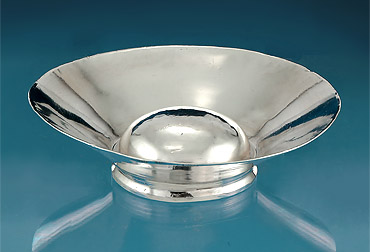
A LOUIS XV BORDEAUX DOMED SILVER WINE TASTER or 'TASTEVIN'
Jean-Francois Jouet, Bordeaux France, 1764-66
With domed center and 'collet' foot, 4" diameter; 2.25 oz (current stock)
The flaring rim and domed
center provide the large surface needed
for a red Bordeaux to develop its flavor.
"... THE EARLY
'TASTING CUPS' in SPAIN & PORTUGAL"
Spain and Portugal also had excellent vineyards and vintners, those in Portugal with Royal patronage.
Spain was a favorite for sherry; however politics and religion often impaired trade with Spain.
Portugal's new king and wine sponsor Dom Afonso Henriques regarded with great importance
the c1150 appointment of Knight Fernão Peresas as Portugal's first
"bearer of the cup",
this Royal position recorded as well by future Portuguese kings.
The 1386 'Treaty of Windsor' further opened a long unbroken period of
mutual support between England and Portugal.
And fortunately, Portugal's position on the Continent was very convenient to British shipping lanes.
During the late 1500s the Iberian Peninsula began to produce the shallow taster
('tembladera') meaning "trembling water" :
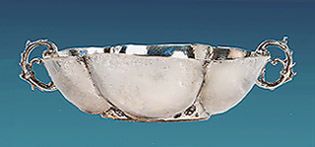
as well as the silver, gold, and even rock crystal
deeper footed 'tasting cups', (the 'bernegal').
These small round footed cups, often lobed and 'punch decorated', with 'two scrolled handles',
were traditionally passed about the table for communal sharing of wines - or chocolates.
The Iberian artistic forms were exported to England
... right along with the wine.
Below is an
English c1640 silver 'tasting cup', in the Portuguese 'bernegal' manner -
lobed and footed on a bladed stem, the deep bowl with punch-decoration.
(former stock)
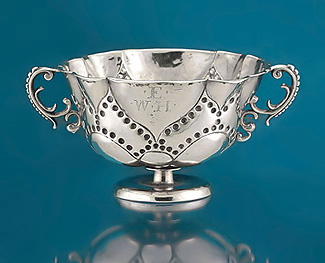
"... THE EARLY 'WINE TASTER' in ENGLAND"
England and Wales had long been beer-drinking countries, as were Scandinavia and Northern Germany.
Scotland was a whiskey region.
Due to climate, the British Isles did not produce its own wines,
importing wines
(quite expensively so) from southern Continental wine growing regions,
as stated, primarily France, and the Iberian Peninsula.
Along with the selected wines, the British often brought back the
REGIONAL WINE TASTERS,
from both France (when Britain and France were not at war),
and the Iberian Peninsula.
In fact from Portugal, they often brought back the silver*** to make tasters - et al.
These
'imported tasters' were considered such a necessity for wine-buying trips
that they were even exempted from British embargo taxes,
During the 16th and early 17th century, Bordeaux was the main source for French wine,**
'Bordeaux' tasters, as
described, having wide sloping sides and a domed center to reflect light.
In the late 20th century, an English silver domed taster dating c1570 was dredged from
the Thames - thus far, the earliest known
"English wine taster" recorded
This taster sold 'quite well'
at Christie's London, December 2019, sale 17725, lot 109.
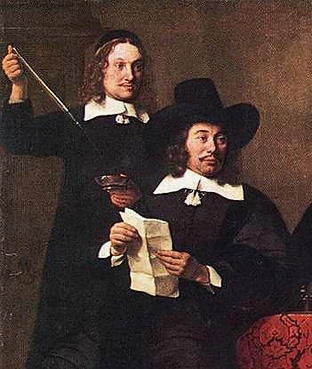
Above is a detail from Ferdinand Bol's 1663 painting, "Governors of the Wine Merchant's Guild",
depicting a man pouring wine into a
'Bordeaux' form wine taster, using a pipette.
As cited, this "Bordeaux" model has been proposed
recently
as the "only true British wine taster".
Below, from our current stock, is an ENGLISH wine taster, after this 'BORDEAUX' model.
This particular taster has no foot, and a domed center rising slightly above the rim,
preventing it from being confused with an open salt :
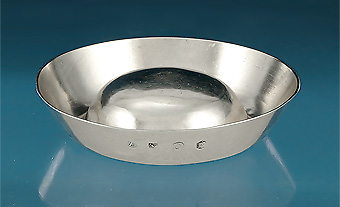
A RARE GEORGE II SILVER 'DOMED' WINE TASTER
Joseph Sanders, London, 1738
fully hallmarked to the side / 4" diameter / 3.2 oz. (current stock)
See Christie's July 2006, James Walker Collection of Silver, lot 203
Along with the
'Bordeaux form' tasters,
England, from c1640 to c1690,
produced a number of small silver vessels in the manner of
Iberian 'tasting cups' and shallow 'tembladeras'.
Those in the 'Iberian-style', with punched bases and sides for reflection,
and twin scrolling elevated handles,
have recently been 'challenged' as true English 'wine tasters',
in part due to the fragility of the handles, and the
greater numbers existing, primarily from the Charles II period.
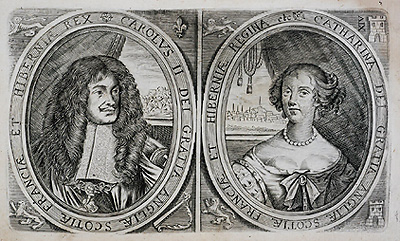
In viewing this 'dispute', the reign of Charles II (1660-1685),
with its opulence and excesses, and existing trade agreements with Portugal,
is possibly quite significant.
Moreover, in 1661, Charles married Catherine de Braganza of Portugal,****
with additional trading rights, including Brazil and the Portuguese East Indies.
Catherine was known to bring
into England and to popularize many goods not yet in use.
There is not a great deal of early literature about English wine tasters.
Most references are more 'mentions' than historic notations.
However, in "Caroline Silver", Charles Oman, noted British silver scholar and author,
acknowledges French and Portuguese forms equally :
"WINE-TASTERS...ARE of
TWO PATTERNS.
The earlier consists of a shallow bowl with two loop handles of wire, the later a shallow bowl
with sloping side and domed center and more substantially made ....
that vintners liked to carry in their pockets."
In Plate 21B, Oman depicts a shallow 1642 London "Wine Taster"
quite similar to the Iberian 'tembladera'
with "catherine wheel"
punched decoration and twin scrolling handles.
Below is a similar
1661 early Carolean punched and handled example (current stock)
:
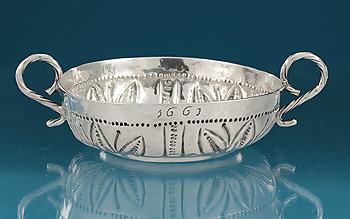
AN EARLY CHARLES II SILVER WINE TASTER, prick engraved 1661
Also with owner's initials H over I.A, and flanked by a pair of scrolling twist handles;
punch-decorated with a central tulip and
foliage
4.75" wide over the handles / 1" High / 1.52 oz.
Below is yet another English silver taster of punched Portuguese influence,
Charles II, probably West Country, c1670 (former stock) :
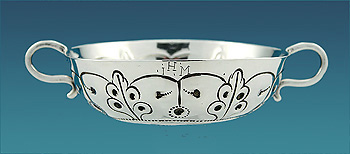
"A FEW ENGLISH FORMS
CLOSELY RELATED
to the handled and/or punched wine taster :"
In "Caroline Silver",
Oman depicts, directly opposite the 1642 wine taster, a set of seven
small 2- handled "Dram Cups", 3-3/4",
also spoken of as 'strong water' or
'aqua vitae', and 'not following any one pattern'.
These deeper
'miniature standing cups'
have also known use as
'wine tasters',
as well as
'miniature porringers',
'gifts' given to new mothers.
The 2.25" high
Commonwealth c1655
Miniature Porringer below
is a good example from our former stock
Visually these cups are quite reminiscent of the deeper 'Iberian bernegal'.
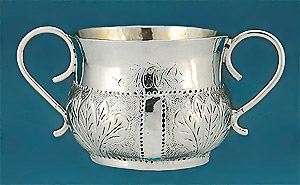
'Dram cup'
is also the name given to most Colonial American shallow twin-handled
punched cups.
George Munson Curtis, in "Early Silver of Connecticut", commented regarding
the early American name :
"Our ancestors were not
wine-tasters
: they drank from beakers, caudle-cups, and tankards".
As well, the V&A Collection lists a few
shallow twin-handed punched cups as
'dram cups'. *****
The
'Cup of Assay'
is yet another very small (4" over handles)
silver taster.
The example below dates from the William & Mary period, 1697-1700.
It is reported that a servant or steward would 'taste a wine',
demonstrating to the host and guests that is was not poisoned.
This size and form is referenced by the Metropolitan
Museum as also a
"possible mustard dish".
(previous stock)
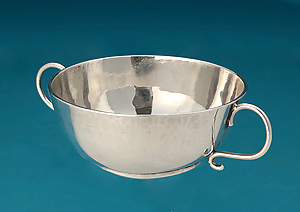
"A Few Further Notes of Discernment :"
The silver 'Sweetmeat Dish' (for candied fruits) is a form often identical to the punched
handled taster.
However, a dish for sweetmeats is
too large
to qualify as a wine taster.
The Continent produced a great number of two-handled tasters, those often being lobed.
Some are larger,
possibly oval, ornately embossed, and engaged as
'Brandy Dishes'.
If gilded, they were not
tasters, but intended for sweetmeats
- the gilding combating the acidity
The Scottish made (from silver, wood, and pewter) the shallow handled
Quaich ******.
However, the Scots, Irish, and Welsh made few - if any - wine tasters.
"ENGLISH PORCELAIN TASTERS & CHINESE INFLUENCE"
During the 17th and 18th century, small wine cups with single small loop or stem handles
were arriving in Europe and England
from China, in jade, rock crystal and porcelain.
These wine cups influenced 18th century British
'wine tasters' made from
newly developed soft paste porcelain.
Above left is a Chinese 18th century lobed jade wine cup,
Metropolitan Museum, 2.5" wide,
such a 'wine cup' influencing the shape of the English 'porcelain wine taster' (above right) :
AN ENGLISH SOFT PASTE PORCELIAN WINE TASTER, Probably
Derby,
England, c1760, with lobed exterior & flat leaf handle, also 2.5" wide (current stock).
British porcelain tasters are recorded by Derby. Worcester, Caughley, Bow, Vauxhall and Longton Hall.
These small porcelain tasters were also made in Portugal,
the repository of some of the best
early Chinese export porcelain.
Although perfect for a small taste of wine,
their exact function apparently remains undocumented.
"18th - 21st CENTURY SILVER WINE TASTERS"
During the 18th century, the English silver wine taster became far rarer than the 17th.
Any English silver wine taster made after 1700 is said to be rare,
and after 1750 is considered "extremely rare".
Even fewer English wine tasters were made in the 19th century.
The English silver taster below dates to 1912, executed in the French manner :
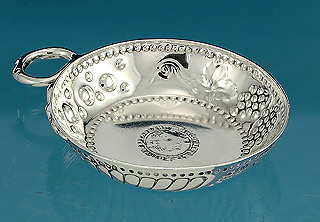
A GEORGE V SILVER WINE TASTER
D & J Wellby, London, 1912
Very heavy gauge silver,
the center inset with a 1575 Elizabeth I sixpence,
the sides punched with flutes, gadrons and grape clusters;
coiled snake handle / 4.75" Diameter 3.9oz (current stock)
Conversely, France, as a wine producing country,
continued their production of wine tasters (tastevins) well into the 19th and 20th centuries.
Though their quality varies, selections can be made to best view the clarity of the wine.
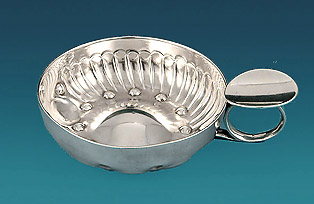
A FIRST STANDARD FRENCH SILVER TASTEVIN (WINE TASTER)
Alfred Feau (Paris 1875-1913), Minerva 1st Standard Silver
traditional wells and flutes single side handle 4-1/8" Over Handle / 3.5 oz.
(current stock)
"REGARDING THE DISPUTE" :
Despite the variances of thought,
the criteria regarding 17th and very early 18th century
English silver 'wine tasters' generally remains akin to that of author Charles Oman :
a SMALL ROUND & SHALLOW CUP,
having good LIGHT REFLECTING DEVICES,
either with or without handles.
The great majority of silver specialists, museums, printed references, and prominent
auction houses continue to refer to the various English forms, 17th through 21st centuries,
with the given light and size properties :
as "WINE TASTERS".
I cannot conclude this description of wine tasters without including
my favorite of all periods - now in a good English collection :
An English Bacchanalian Silver Wine Taster
Rosenthal, Jacob & Co., London, 1884
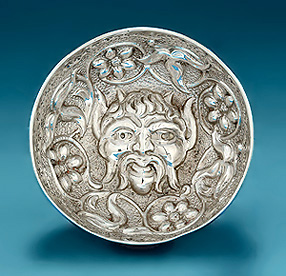
What better way to view wine than through the eyes of Bacchus himself!
ENJOY!
Footnotes :
* Minoan Culture : The Minoan civilization was a Bronze Age Aegean civilization on the island
of Crete and nearby Aegean Islands, the earliest beginnings c3500 BC, the complex urban
civilization beginning c2000 BC, and declining from c 1450 BC until ending c1100 BC.
**
After John inherited the English throne, in 1203 he exempted
Bordeaux
merchants from 'export tariffs'.
With this
exemption and favored treatment in London,
Bordeaux wine
became the cheapest wine
in the London market and gained
immense popularity among the English, who called it
'claret'.
*** Silver
was being imported in boatloads
by 17th century Portuguese, from their own mines in Brazil.
****
Negotiations for the marriage between
Charles II and Catherine de Braganza
began in the 1740s,
and were renewed immediately after the Restoration (1660). This contract secured for England,
Tangier and the Seven Islands of Bombay (India), trading privileges in Brazil and the Portuguese East Indies,
religious and commercial freedom for English residents in Portugal, and two million Portuguese crowns.
Further, Catherine's arrival brought and promulgated many Portuguese goods and imports,
including cane, lacquer, cottons, and porcelain. Additionally Catherine is credited with popularizing tea in Britain.
****** A Dram
is defined as roughly a mouthful - just over an ounce. The word is derived from the
ancient Greek word drakhme, which means coin.
***** Below is a
Scarce George III Scottish Provincial Quaich,
Charles Jamieson, Inverness, c1810,. the twin shaped lugs engraved AMG, and PML,
similar in form to the 'English wine taster'
(former stock).
The form of the small low silver 'quaich' and 17th century 'wine taster' is quite evident.
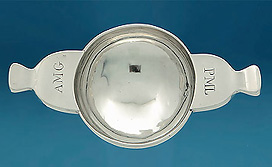
"Caroline Silver", Charles Oman, 1970, Farber & Farber. This book ,... "with its ex cathedra
identification for the first time of the makers of some of the most important pieces of Caroline
plate, is undoubted one of the greatest contributions to knowledge of the period... "
"Monk Testing Wine",
Antonio Casanova y Estorach, c1886, Brooklyn Museum, USA
Creative Commons
"Governors of the Wine Merchant's Guild of Amsterdam"
, Ferdinand Bol, 1663,
Alte Pinakothek, Bavaria, Creative Commons
"Portraits of Rex Carolus II (Charles II of England)
& his wife Regina Catharina (Catherine of Braganza)",
Salmon, William, 1644-1713, Plate XIV, Library Collections,
Science History Institute, Philadelphia, United States, Creative Commons
Inventory Photography :
Millicent F. Creech
With thanks to the highly regarded silver specialists in the UK
who assisted in clarifying the history and structure of the early English wine taster.
|